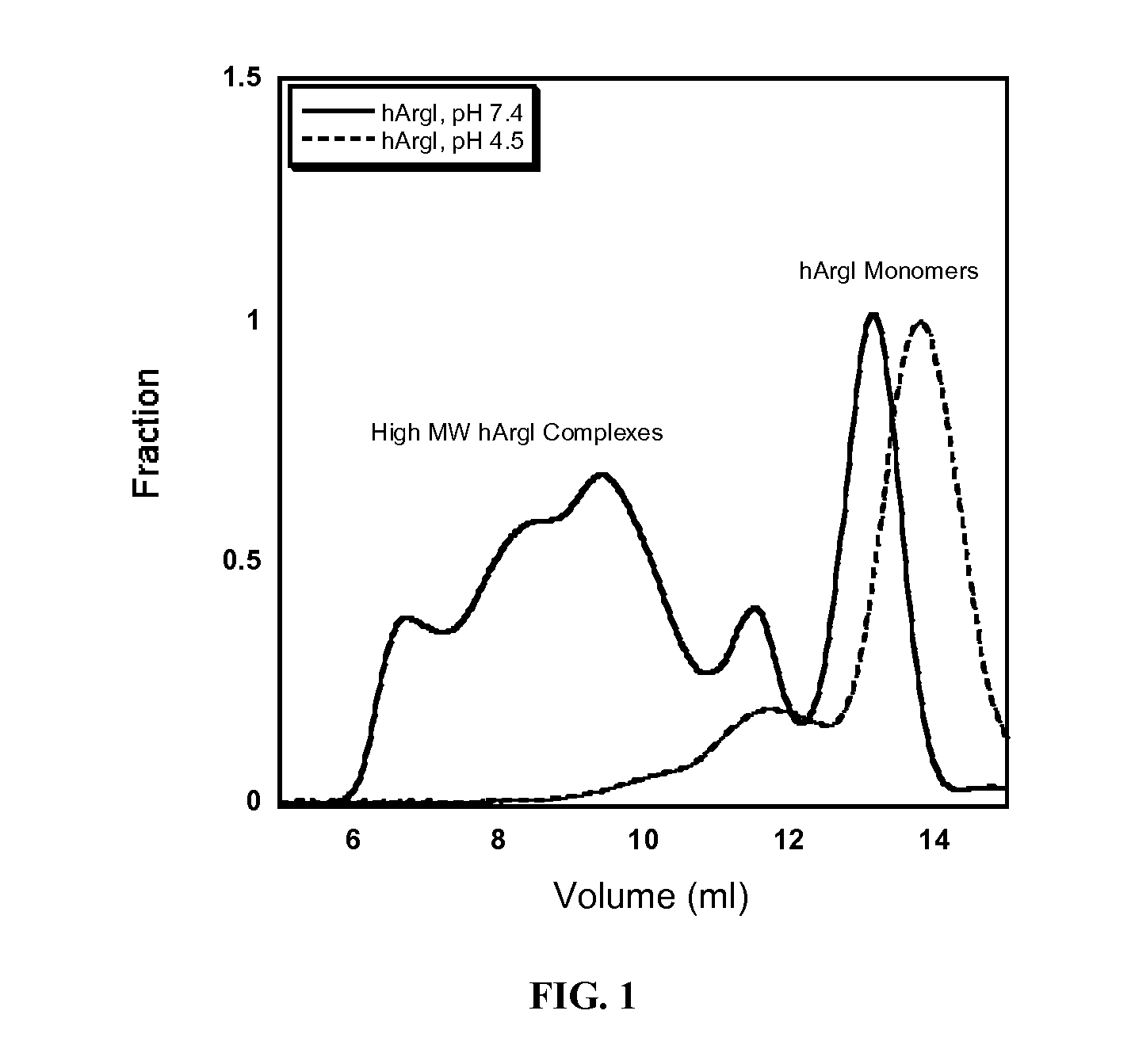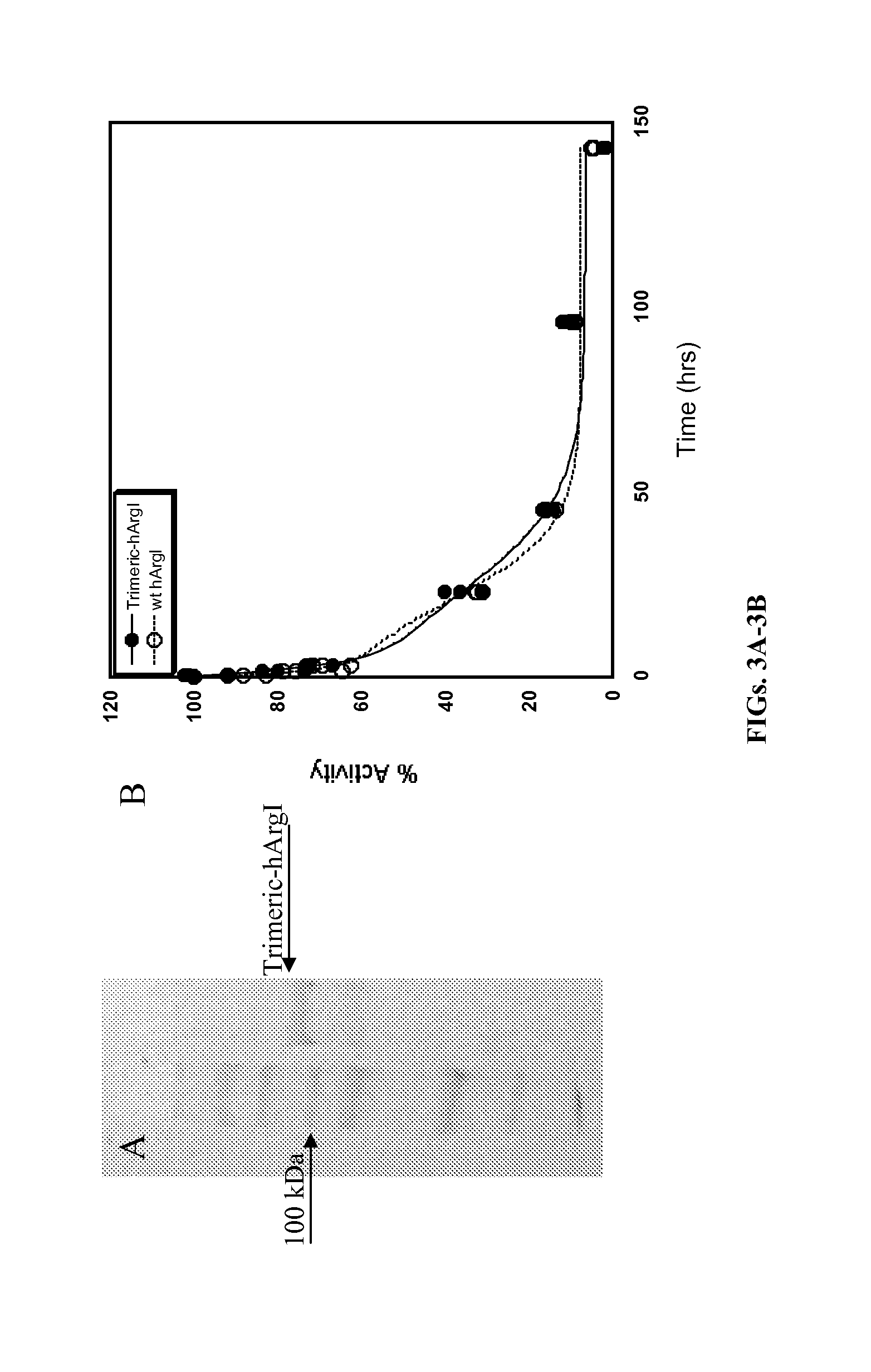Arginase formulations and methods
a technology of arginase and formulations, applied in the field of protein therapeutics, can solve the problems of short half-life, deactivation of enzymes, and polypeptides that are prone to filtration in the kidneys, and achieve the effects of increasing the molecular weight of protein therapeutics, increasing the retention rate in circulation, and high homogeneity
- Summary
- Abstract
- Description
- Claims
- Application Information
AI Technical Summary
Benefits of technology
Problems solved by technology
Method used
Image
Examples
example 1
Introduction of N-Terminal Cys Residue, Purification and Pegylation
[0123]The inventors constructed a nucleotide sequence containing an E. coli codon optimized gene of human Arginase I (hArgI) prefaced with a codon for Cys on the third residue and a 6×His tag for ease of purification (Called NTC-hArgI; SEQ ID NO:2 encoding an amino acid sequence as set forth in SEQ ID NO:1). After cloning into a pET28a vector (Novagen), E. coli (BL21) containing an appropriate Arginase expression vector were grown at 37° C. using Terrific Broth (TB) media containing 50 μg / ml kanamycin in shake flasks at 250 rpm until reaching an OD600 of 0.5-0.6. At that point the cultures were transferred to 25° C. and induced with 0.5 mM IPTG and allowed to express protein for an additional 12 hrs. Cell pellets were then collected by centrifugation and re-suspended in an IMAC buffer (10 mM NaPO4 / 10 mM imidazole / 300 mM NaCl, pH 8). After lysis by a French pressure cell, lysates were centrifuged at 20,000×g for 20 mi...
example 2
Separation of Pegylated and Unpegylated hArgI
[0124]Size exclusion chromatography is commonly employed to separate pegylated proteins from unreacted material. However the separation of pegylated hArgI from the native enzyme has proven problematic due to the high oligomerization propensity of hArgI. Separations on a Superdex 200 column (Pharmacia Biotech) using PBS pH 7.4 as a mobile phase revealed that hArgI is present in a variety of oligomeric states ranging from trimers to nonamers resulting in poor separation of pegylated material. Likewise a sephacryl S-500 (GE Healthcare) did not result in any better resolution. The inventors therefore engineered an E256Q mutation into the NTC-hArgI coding sequence. The E256Q mutant was previously shown to exist as a monomer with near wild-type activity (Sabio et al., 2001). The inventors' gel filtration experiments with this variant showed that it exists mainly as monomers and dimers with no observable higher order oligomerization. After conju...
example 3
Creation of a Multimeric Human ArginaseI
[0126]The active and predominant oligomeric state of hArgI is the trimeric form (MW ˜105,000 Da). However in circulation, dissociation into the 35,000 Da monomer subunits results in a species that is below the cut-off for renal filtration which in turn results in renal clearance within minutes. The trimer-monomer equilibrium thus adversely impacts the half-life of hArg in mammalian circulation. To overcome the circulatory clearance the inventors created a trimeric hArgI fusion protein connected by flexible Gly / Ser linkers (SEQ ID NO:3), which is stabilized in the trimeric form in circulation.
[0127]Nucleic acid sequences encoding trimeric hArgI fusion protein (SEQ ID NO:4) was constructed in several stages, such that the coding sequence for each hArgI subunit (hArgI 1-3) was cloned separately into a pET28a vector for sequence verification before consolidation as a fusion protein in a single pET28a vector.
[0128]hArgI-1 Using an E. coli codon opt...
PUM
| Property | Measurement | Unit |
|---|---|---|
| Time | aaaaa | aaaaa |
| Time | aaaaa | aaaaa |
| Time | aaaaa | aaaaa |
Abstract
Description
Claims
Application Information
 Login to View More
Login to View More - R&D
- Intellectual Property
- Life Sciences
- Materials
- Tech Scout
- Unparalleled Data Quality
- Higher Quality Content
- 60% Fewer Hallucinations
Browse by: Latest US Patents, China's latest patents, Technical Efficacy Thesaurus, Application Domain, Technology Topic, Popular Technical Reports.
© 2025 PatSnap. All rights reserved.Legal|Privacy policy|Modern Slavery Act Transparency Statement|Sitemap|About US| Contact US: help@patsnap.com



